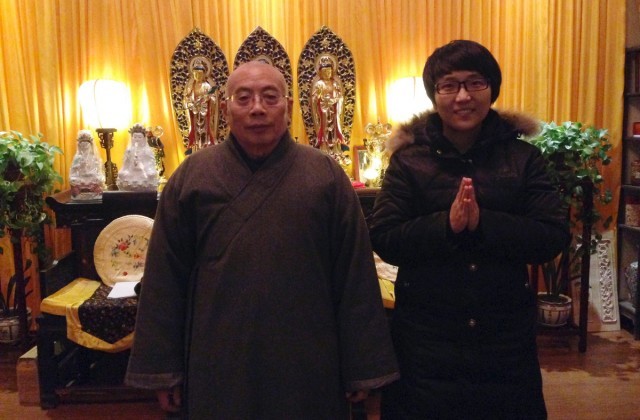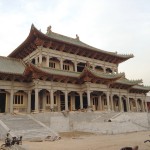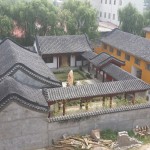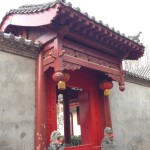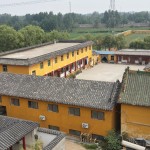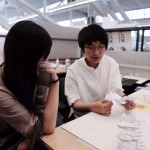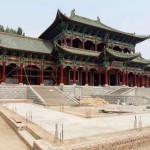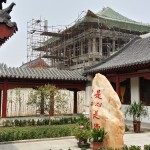Autumn Zhao Builds for the Future by Discovering the Past
With a couple of Brenau degrees, the Chinese student returned to her home to help with construction of a new Buddhist temple as the Chinese government relaxes restrictions on religious practices.
By Alison Reeger Cook
About an hour and a half drive north of Mengqiu “Autumn” Zhao’s home in Zhengzhou, China, lies the city of Jiaozuo. There the Shifo Buddhist Temple was established in the year 948 – about 930 years before the founding in the United States of what is now Brenau University. The connection between the two institutions flows through Zhao, WC ’14, BU ’15.
Known at Brenau as “Autumn,” which is a translation of her Chinese given name, Zhao completed an undergraduate degree in music and a master’s degree in interior design at Brenau before returning home to the Henan province of China to help research, plan and develop the construction of the new Shifo temple. Although the ruling Chinese Communist Party is officially atheist, it has grown more tolerant of religious activity recently, says the Council on Foreign Relations. Religious observance in the nation is on the rise, particularly among young adults, many of whom have become adherents of traditional Chinese religions, especially Buddhism.
The Shifo Temple builders use modern materials, such as concrete and bricks, but the work also includes the traditional elements prevalent in Chinese religious architecture for hundreds of years – a tile-roofed front gate, monks’ residences, the abbot’s quarters, courtyard, refectory and lecture halls. With the expansion of land acquired in 2014, the temple is now almost complete.
Tapping into a history of more than 1,500 years, the temple is affiliated with the Shaolin Temple in Dengfeng, which is an iconic example of China’s rich architecture of the period and is also one of the most important origins of kung fu, a term most often used in reference to a form of martial arts but which actually refers to the mastery of any art through development of skills, patience and practice.
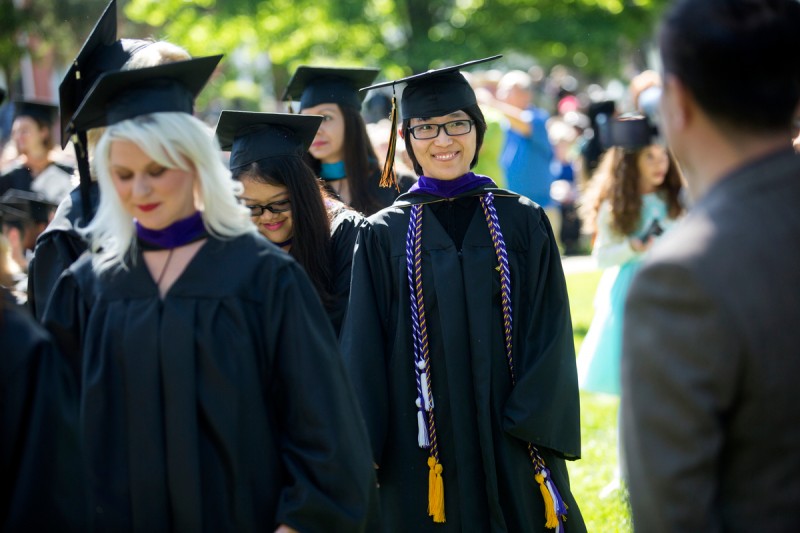
Zhao studied architecture for two years at Zhengzhou University, from which in recent years a number of Brenau students have originated. After she learned about the school in Georgia from one of her professors, Zhao transferred to Brenau. She won a full scholarship and completed a B.A. in music and interior design in 2014. She then launched immediately into the Master of Interior Design program, which she completed in May 2015.
“I learned so much at Brenau, not just the specifics [of design] but the way of thinking, of how to develop and push myself in the process of design,” she says. “There are so many layers, revisions and problems to solve. You’re never truly finished. There is always something that you can do to make your work better.”
Having learned about the temple from a fellow architecture student, she has been working on it since 2013 during long breaks in her Brenau studies. Now back home in China, she is applying to architecture schools in the States, but she still plans to do some more work at the temple during 2016.
AWAKENING
In the middle of a Shifo temple courtyard of vibrant greenery surrounded by currant-red pillars, a large white stone engraved with crimson Chinese symbols displays the message, “The heart is Buddha.” In the Buddhist religion, all things are connected to “the awakened one,” founder of the traditions and practices, who embodies of enlightenment. If the heart is Buddha, then the heart has become fully enlightened.
Studying one’s field is only part of the journey for a student in a university. Putting what one has learned into practice and understanding the process of one’s work is important as well, but it is developing a particular way of thinking – essentially, one’s own “enlightenment” about their pursuits and passions – that empowers the student to develop who he or she is, both as a professional and as a person. Zhao says she began that epiphany when she returned home to work on the temple project. It was a nexus for history and traditions of her homeland and the product of the melding of what she had learning in school and what she would do in life.
She had been thinking about a career as early as middle school and high school, where she was interested in science and math. She considered becoming a scientist, but realized she didn’t want to limit herself. As soon as she left Brenau after commencement in 2015, she attended a summer career discovery program at Harvard University Graduate School of Design, and after close to a decade of thought, she has about settled on a final road to her destination.
“I have always wanted to do something practical in the real world that combined science, technology and art – and that would help people,” she said. Early on the journey, she read an article about architecture and discovered it was a great way to use all her passions – history, culture, art and science – into an organic combination. She has now decided that architecture is exactly what she wants in a career: something “challenging and fascinating.”
Lynn M. Jones, chair of the interior design department at Brenau, says it is precisely Zhao’s Zen-like deep thinking about where one fits into the world that made her such a “cherished student” in the American university.
“Menqqiu creates interiors that express a sense of place,” Jones says. “I look forward to following her career path as she continues defining her design voice.”
In addition to her embracing the role of student at Brenau, Zhao wants to share those things she has mastered, sharing specifically with architecture and design students – both in China and the western world – how beautiful and enriching her country’s architecture and history is and how those things testify to multi-millennia of China’s native history and heritage.
“[My country] is a great resource for those who want to work in the design industry to look to and be inspired by,” she says.
NEW WAVE
Zhao and other Brenau alumni who originated in the People’s Republic of China have paved the way for a new wave of students who will touch Brenau in the summer of 2016. The students are part of a series of 2+2 programs with Chinese institutions – the name stemming from the fact that the students will complete the first two years of their undergraduate studies at their home institution in China then “transfer” to Brenau for their junior and senior years and then graduate as Brenau alumni. The first group of 27 Anhui Normal University early childhood education majors will arrive in Gainesville in time to begin the 2016 fall semester. When they move up to their senior year, they’ll be joined by another group of about 30 who’ll come in. The first group will graduate just as the third group comes in for its junior year – part of a continuing process. In 2017 Brenau envisions adding another Anhui 2+2 program for undergraduate English majors as well as a group of undergraduate nursing students from Anhui College of Traditional Chinese Medicine. The three programs, when fully implemented in about three years’ time, will bring a steady stream of about 180 students a year as they complete the last two years of their undergraduate studies at Brenau.
Zhao says that she believes Brenau will be a great fit for the incoming students.
“Attending Brenau is a different experience from attending university in China,” she said. “There is a large population of students in China with classes of hundreds of students. Brenau is peaceful and has smaller classes. I enjoyed the close relationships between students and teachers. The professors were always willing to help you if you have a problem. Since I was a double major, I had trouble figuring out how to find time to fit in all my classes, but my professors helped me solve my time conflicts. You can’t get that kind of one-on-one attention in a Chinese university.”
What would she tell a Brenau-bound Chinese student?
“I would to share with them that Brenau is such a warm place,” she says. “Other students and friendly people in the community could become lifelong friends. During my years at Brenau, I felt it was my home away from home.”
- Buddha’s Word carved on a stone in the Abbott’s Yard of the Shifo Buddhist Temple.
- Construction on the front entrance to the Buddhist temple.
- The Abbott’s Yard of the Buddhist temple.
- The entry to the Abbott’s Yard.
- The Abbott’s Yard, including the monks’ dining and living quarters.
- Construction on the roof of the Buddhist temple.
- Autumn Zhao works alongside a fellow architect on models for the Buddhist temple.
- The front entrance to the Shifo Buddhist Temple, closer to completion.
- Ground view of the construction of the roof from the Abbott’s Yard.
